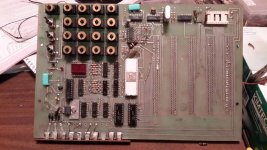First computer I built. Came with a PCB board, a 1802 and 1851 and some TTL chips. I bought extra sockets because I thought I might nuke a few soldering them in. Soldering the hex keypad on was the worst. I was twelve at the time.
It DID work. The thing taught me hand assembly. As in, writing mnemonics on paper and hand assembling to opcodes. Then keying it all in and seeing what happens. A big step up from writing BASIC on a trash-80. And really helped me transition to z-80 assembly. Which, I probably could have done without it. But I didn't believe I could. So the ELF trainer route it was.
A nifty project for a kid back in 1980. Does anyone here remember them? I know there are some 1802 fans still out there. And chip-8 still seems to be a thing (though I never used it back then).
It DID work. The thing taught me hand assembly. As in, writing mnemonics on paper and hand assembling to opcodes. Then keying it all in and seeing what happens. A big step up from writing BASIC on a trash-80. And really helped me transition to z-80 assembly. Which, I probably could have done without it. But I didn't believe I could. So the ELF trainer route it was.
A nifty project for a kid back in 1980. Does anyone here remember them? I know there are some 1802 fans still out there. And chip-8 still seems to be a thing (though I never used it back then).


